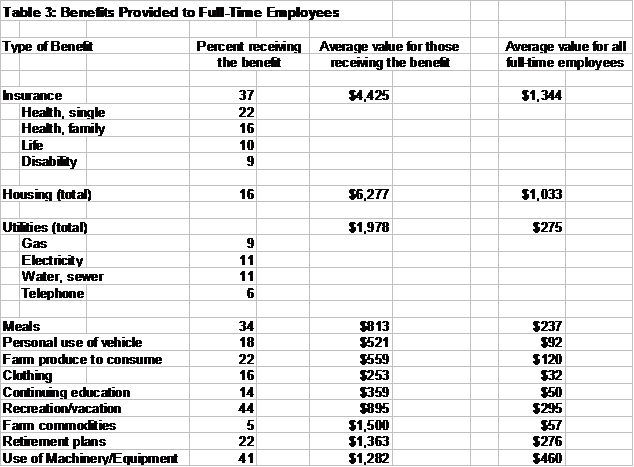Benefits for farm employees vary tremendously from farm to farm and frequently take the place of some wages that might normally be paid to employees in a non-farm position. With very little data available addressing the value of benefits provided, this survey was conducted to collect and share baseline data for farm employers and employees.
A survey was conducted in early 2007 to gather data on farm employee wages and benefits in Ohio. The “Wages and Benefits For Farm Employees” study was conducted by distribution of surveys by Extension Educators, Agricultural, Environmental and Development Economics Faculty and Staff and allied organizations. Surveys were returned and summarized for 122 farm employees in early 2007. Data was collected for each employee on benefits including health insurance, life insurance, disability insurance, housing, utilities, meals, personal use of vehicle, farm produce to consume, clothing, continuing education, recreation/vacation, farm commodities, retirement plan, and use of machinery and equipment.
In this study we collected data for full-time and part-time farm employees. The benefits summary shown below reflects benefits paid to full-time employees only.
Thirty-seven percent of full-time employees from this study received some form of insurance. Twenty-two percent of full-time farm employees received single person health insurance while 16% received family health insurance. The average value of the insurance benefit for those receiving the benefit was $4,425 per employee per year. The average value for all full-time employees in this study was significantly less at $1,344 per person per year due to a large number of employees receiving no insurance. (Sixty-three percent of this sample received no health insurance.)
Sixteen percent of full-time employees received housing as a part of their compensation package. The value of housing for those receiving the benefit averaged $6,277 per year. The average for all employees was $1,033 per year. Along with housing, some employees were compensated with paid utilities. For those receiving this benefit, the average value of the benefit was $1,978 per year. The average for all full-time employees was $275 per year. This much lower average value for all full-time employees is due to a large percentage not receiving this benefit.
Other significant forms of benefits for full-time farm employees include meals (34% received the benefit), paid recreation/vacation (44% received the benefit) and use of machinery and equipment (41% received the benefit). A breakdown of benefits received by full-time farm employees is shown in Table 3 below. Table 3 shows the percentages of farm employees receiving certain benefits along with average amounts paid to full-time farm employees.
Summary data presented in this paper is the second in a series of papers examining the findings of this research study. Further articles and papers will be available through the Ohio Ag Manager Newsletter http://ohioagmanager.osu.edu/, Ohioline http://ohioline.osu.edu/, and the OSU Department of Agricultural, Environmental, and Development Economics Farm Management http://www-agecon.ag.ohio-state.edu/.
